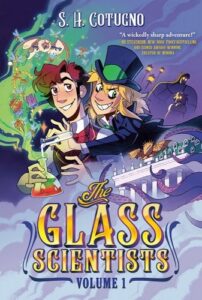The Glass Scientists, Volume 1 by S. H. Cotugno
Razorbill, 2023
ISBN-13: 978593524442
Available: Hardcover, paperback, Kindle
Buy: Bookshop.org | Amazon.com
The Glass Scientists is a webcomic created by S. H. Cotugno. Set in 19th Century London, Dr. Henry Jekyll founds The Society for Arcane Sciences, a place where mad scientists prove they are more than just that. They can thrive in an accepting environment where they can conduct their experiments without fear of interruption, defy laws of nature while in a safe area, and make friends while doing it. London isn’t the ideal environment for these eccentrics, with officers of the law and other officials concerned about their practices after the Frankenstein incident. With mobs taking it into their own hands, or pitchforks and torches, to hunt down what they don’t understand, Dr. Jekyll has his work cut out for him in trying to improve public opinion, as well as keeping up the morale of the scientists within the walls of the Society. There is also the new play debuting right across the street, allegedly based on the “very real” story of Dr. Frankenstein and his Creature, just as Dr. Jekyll is about to show everyone the value of the Society within London.
So many things are against the good doctor. His own alter ego, Edward Hyde, is hellbent on running amok, and nearly causes the complete dissolution of the Society for Arcane Sciences. The Creature arrives, carrying the very doctor who created him, Dr. Frankenstein: both prove to be quite different from the little play going on across the street. Things spiral further out of Dr. Jekyll’s control, and his once loyal friends and colleagues begin to turn against him. Their search for the mysterious and dangerous Mr. Hyde is yielding no results: Dr. Jekyll, having shut him into the deepest corners of his mind, thinks them both safe. He is terribly wrong.
I enjoyed this interpretation of the Jekyll and Hyde tale. Rather than being fully separate from each other, each knew the other was present. They could hold conversations together and understand each other’s thoughts and motivations. The transitions between Jekyll and Hyde’s dialogue were easy to follow, as the text was white against a black field when Hyde was communicating in the doctor’s head. Dr. Jekyll could also allow Hyde to take over for a time, with Jekyll’s tall brunette gentlemanly figure turned into the green-eyed, blond-haired, unkempt Hyde. You know mischief will ensue with Hyde around. The Society’s lodgers are a great addition to the story. Newly discovered werewolf Jasper Kaylock, manager and cook of the Society Rachel Pidgley, and Dr. Frankenstein are fantastic characters. A few examples of the Society’s scientists are Miss Lavendar, a Junior Extremofaunic Zoologist; Dr. Ranjit Helsby, Exploratory Bathynaut; and Dr. Maijabi, Ectoplasmic Pathologist. I loved all of them, but I won’t list them all here.
The artwork in The Glass Scientists is crisp and the colours are wonderful. Volume One collects Chapters 1-7 of the webcomic and includes a short story, “The Creature and the Coffeehouse”, as well as“The Vault,” which includes a brief history of Cotugno’s creative process, and additional materials. The story contains LGBTQ+ themes and characters, making this an inclusive title. The creator recommends the comic for ages 13 and up. The creator of one of my favourite shows, The Owl House, wrote a blurb for the first volume, which gave me a hint that I would enjoy it. Highly recommended.
Reviewed by Lizzy Walker







Follow Us!